door lock HONDA ACCORD COUPE 2001 CF / 6.G Owners Manual
[x] Cancel search | Manufacturer: HONDA, Model Year: 2001, Model line: ACCORD COUPE, Model: HONDA ACCORD COUPE 2001 CF / 6.GPages: 372, PDF Size: 6.1 MB
Page 5 of 372
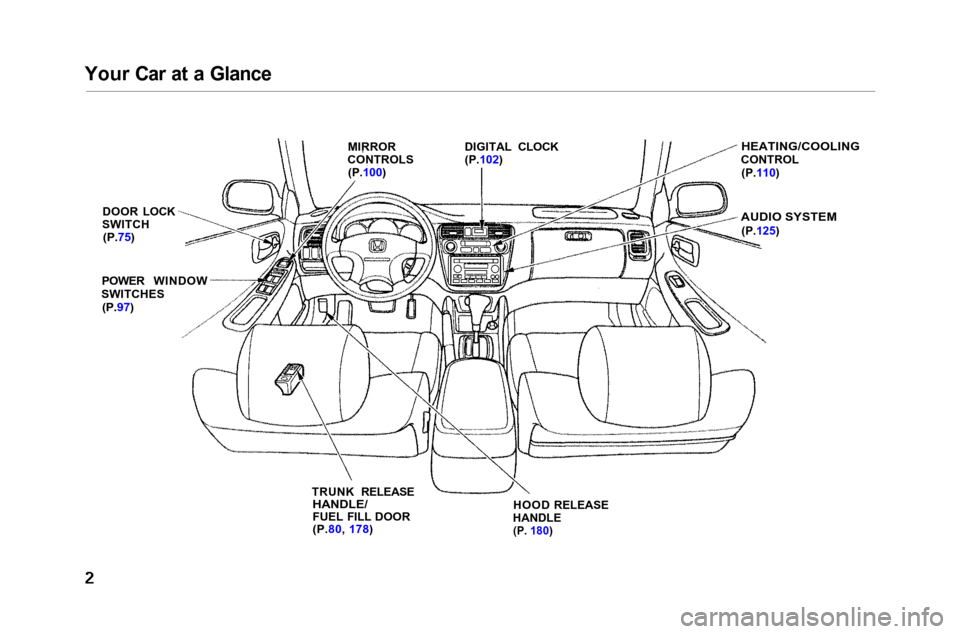
Your Car at a Glance
DOOR LOCK
SWITCH
(P.75)
POWER WINDOW
SWITCHES
(P.97)
MIRROR
CONTROLS (P.100)
HEATING/COOLING
CONTROL (P.110)
AUDIO SYSTEM
(P.125)
TRUNK RELEASE
HANDLE/
FUEL FILL DOOR
(P.80, 178) HOOD RELEASE
HANDLE
(P.
180)
DIGITAL CLOCK
(P.102)
Page 8 of 372
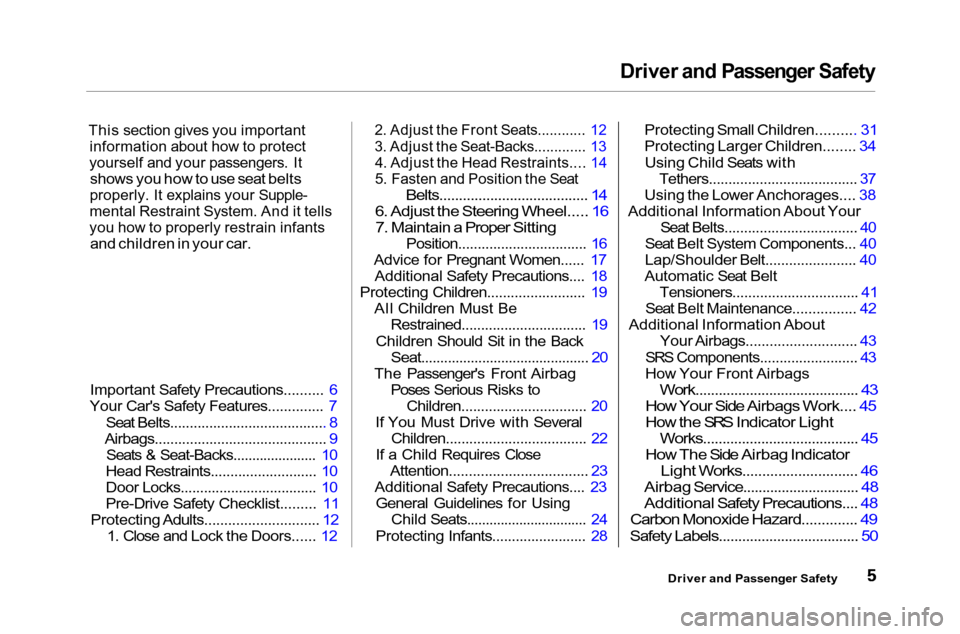
Driver and Passenger Safety
This section gives you important
information about how to protect
yourself and your passengers. It
shows you how to use seat belts
properly. It explains your Supple-
mental Restraint System. And it tells
you how to properly restrain infants
and children in your car.
Important Safety Precautions.......... 6
Your Car's Safety Features.............. 7
Seat Belts........................................ 8
Airbags............................................ 9
Seats & Seat-Backs...................... 10
Head Restraints........................... 10
Door Locks................................... 10
Pre-Drive Safety Checklist......... 11
Protecting Adults............................. 12
1. Close and Lock the Doors...... 12
2. Adjust the Front Seats............ 12
3. Adjust the Seat-Backs............. 13
4. Adjust the Head Restraints.... 14
5. Fasten and Position the Seat
Belts...................................... 14
6. Adjust the Steering Wheel..... 16 7. Maintain a Proper Sitting
Position................................. 16
Advice for Pregnant Women...... 17 Additional Safety Precautions.... 18
Protecting Children......................... 19 All Children Must Be Restrained................................ 19
Children Should Sit in the Back
Seat............................................ 20
The Passenger's Front Airbag Poses Serious Risks toChildren................................ 20
If You Must Drive with Several Children.................................... 22
If a Child Requires Close
Attention................................... 23
Additional Safety Precautions.... 23 General Guidelines for Using Child Seats................................ 24
Protecting Infants........................ 28 Protecting Small Children.......... 31
Protecting Larger Children........ 34
Using Child Seats with
Tethers...................................... 37
Using the Lower Anchorages.... 38
Additional Information About Your
Seat Belts.................................. 40
Seat Belt System Components... 40
Lap/Shoulder Belt....................... 40
Automatic Seat Belt
Tensioners................................ 41
Seat Belt Maintenance................ 42
Additional Information About
Your Airbags............................ 43
SRS Components......................... 43
How Your Front Airbags
Work.......................................... 43
How Your Side Airbags Work.... 45
How the SRS Indicator Light
Works........................................ 45
How The Side Airbag Indicator
Light Works............................. 46
Airbag Service.............................. 48
Additional Safety Precautions.... 48
Carbon Monoxide Hazard.............. 49
Safety Labels.................................... 50
Driver and Passenger Safety
Page 10 of 372

Your Car's Safety Features
(1) Safety Cage (2) Crush Zones
(3) Seats & Seat-Backs
(4) Head Restraints
(5) Collapsible Steering Column
(6) Seat Belts
(7) Front Airbags
(8) Side Airbags*
(9) Door Locks
* : If equipped Your car is equipped with many
features that work together toprotect you and your passengersduring a crash.
Some safety features do not require any action on your part. These
include a strong steel framework
that forms a safety cage around the passenger compartment; front and
rear crush zones that are designed to
crumple and absorb energy during a
crash; and a collapsible steering
column.
These safety features are designed to reduce the severity of injuries in acrash. However, you and your
passengers can't take full advantage of these safety features unless you
remain sitting in a proper position
and always wear your seat belts
properly. In fact, some safety
features can contribute to injuries if they are not used properly.
Driver and Passenger Safety
Page 13 of 372
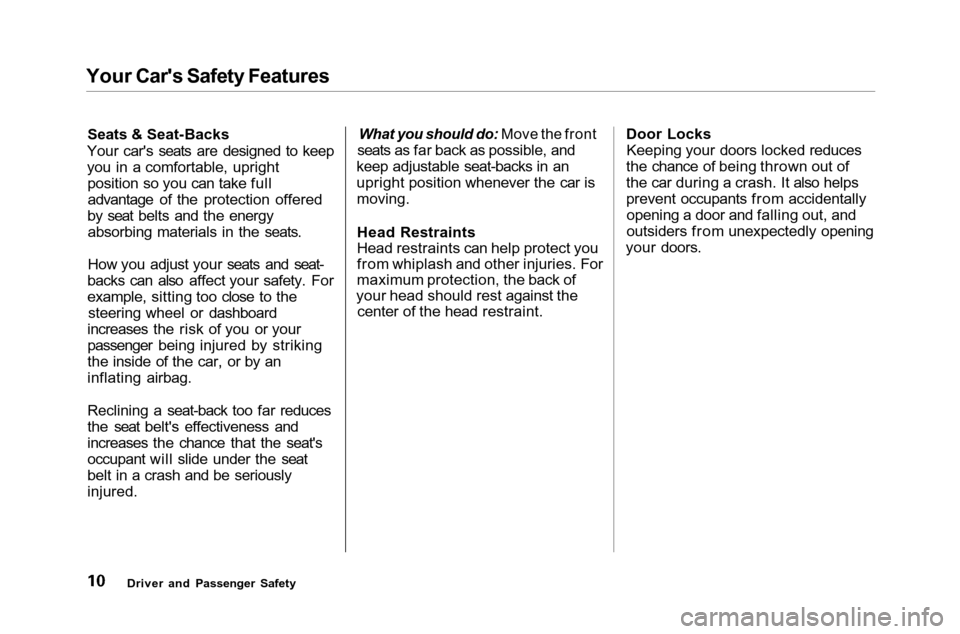
Your Car's Safety Features
Seats & Seat-Backs
Your car's seats are designed to keep
you in a comfortable, upright position so you can take fulladvantage of the protection offered
by seat belts and the energy absorbing materials in the seats.
How you adjust your seats and seat-
backs can also affect your safety. For
example, sitting too close to the steering wheel or dashboard
increases the risk of you or your
passenger being injured by striking
the inside of the car, or by an
inflating airbag.
Reclining a seat-back too far reduces
the seat belt's effectiveness and
increases the chance that the seat's
occupant will slide under the seat
belt in a crash and be seriously
injured.
What you should do: Move the front
seats as far back as possible, and
keep adjustable seat-backs in an
upright position whenever the car is
moving.
Head Restraints
Head restraints can help protect you
from whiplash and other injuries. For
maximum protection, the back of
your head should rest against the center of the head restraint. Door Locks
Keeping your doors locked reduces
the chance of being thrown out of
the car during a crash. It also helps
prevent occupants from accidentally opening a door and falling out, and
outsiders from unexpectedly opening
your doors.
Driver and Passenger Safety
Page 14 of 372
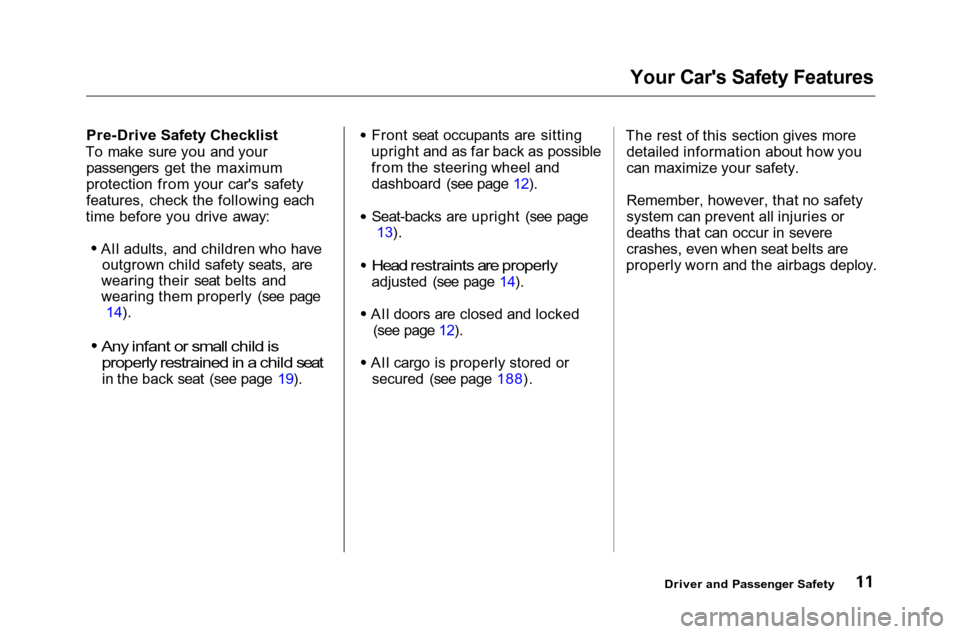
Your Car's Safety Features
Pre-Drive Safety Checklist
To make sure you and your passengers get the maximum
protection from your car's safety
features, check the following each
time before you drive away:
All adults, and children who haveoutgrown child safety seats, are
wearing their seat belts and
wearing them properly (see page 14).
Any infant or small child is properly restrained in a child seat
in the back seat (see page 19). Front seat occupants are sitting
upright and as far back as possible
from the steering wheel and dashboard (see page 12).
Seat-backs are upright (see page 13).
Head restraints are properly
adjusted (see page 14).
All doors are closed and locked (see page 12).
All cargo is properly stored or secured (see page 188). The rest of this section gives more
detailed information about how you
can maximize your safety.
Remember, however, that no safety
system can prevent all injuries or
deaths that can occur in severe
crashes, even when seat belts are
properly worn and the airbags deploy.
Driver and Passenger Safety
Page 15 of 372
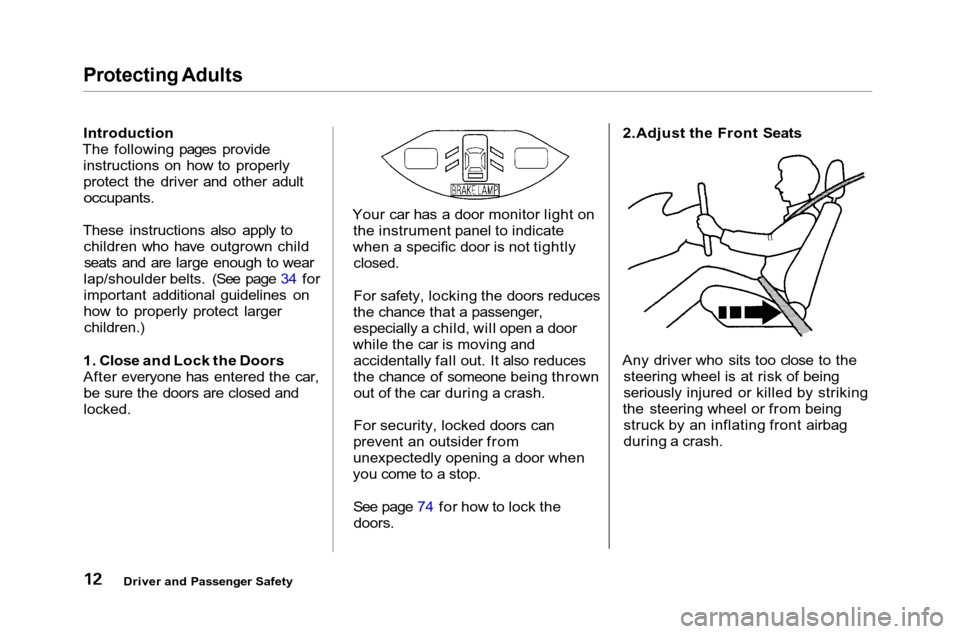
Protecting Adults
Introduction
The following pages provide instructions on how to properly
protect the driver and other adult
occupants.
These instructions also apply to children who have outgrown childseats and are large enough to wear
lap/shoulder belts. (See page 34 for
important additional guidelines on
how to properly protect larger children.)
1. Close and Lock the Doors After everyone has entered the car, be sure the doors are closed and
locked.
Your car has a door monitor light on
the instrument panel to indicate
when a specific door is not tightly
closed.
For safety, locking the doors reduces
the chance that a passenger, especially a child, will open a door
while the car is moving and accidentally fall out. It also reduces
the chance of someone being thrown out of the car during a crash.
For security, locked doors can
prevent an outsider from
unexpectedly opening a door when
you come to a stop.
See page 74 for how to lock the
doors.
2.Adjust the Front Seats
Any driver who sits too close to the steering wheel is at risk of being
seriously injured or killed by striking
the steering wheel or from being struck by an inflating front airbag
during a crash.
Driver and Passenger Safety
Page 26 of 372

Protecting Children
If a Child Requires Close
Attention
Many parents say they prefer to put
an infant or small child in the front
passenger seat so they can watch the
child, or because the child requires
attention.
Placing a child in the front seat
exposes the child to hazards from
the passenger's front airbag, and
paying close attention to a child distracts the driver from the
important tasks of driving, placing
both of you at risk.
If a child requires physical attention or frequent visual contact, we
strongly recommend that another
adult ride with the child in the back seat. The back seat is far safer for a
child than the front. Additional Safety Precautions
Use childproof door locks to
prevent children from opening the
doors. Using this feature will
prevent children from opening the doors and accidentally falling out (see page 80).
Use the main power window
switch to prevent children from
opening the rear windows. Using
this feature will prevent children
from playing with the windows,
which could expose them to
hazards or distract the driver (see page 97).
Do not leave children alone in your
vehicle. Leaving children without
adult supervision is illegal in most
states and Canadian provinces,
and can be very hazardous. For
example, infants and small
children left in a vehicle on a hot day can die from heatstroke. And
children left alone with the key in
the ignition can accidentally set
the vehicle in motion, possibly
injuring themselves or others.
Driver and Passenger Safety
Page 27 of 372

Protecting Children
Lock all doors and the trunk when
your car is not in use. Children
who play in cars can accidentally get trapped inside the trunk.
Teach your children not to play in or around cars. Know how to
operate the emergency trunk
opener (see page 81) and decide if your children should be shownhow to use this feature.
Keep car keys and remotetransmitters out of the reach of
children. Even very young
children learn how to unlock
vehicle doors, turn on the ignition, and open the trunk, which can
lead to accidental injury or death. General Guidelines for Using
Child Seats
The following pages give general guidelines for selecting and installing
child seats for infants and smallchildren.
Selecting a Child Seat
To provide proper protection, a child seat should meet three
requirements:
1. The child seat should meet safety
standards. The child seat should
meet Federal Motor Vehicle Safety Standard 213 (FMVSS 213)or Canadian Motor Vehicle Safety
Standard 213 (CMVSS 213). Look
for the manufacturer's statement of compliance on the box and seat.
2. The child seat should be of the
proper type and size to fit the child.
Infants: Children up to about one
year old should be restrained in a rear-facing, reclining child seat. Only
a rear-facing seat provides the
proper support to protect an infant's
head, neck, and back. See page 28 for additional information on
protecting infants.
Driver and Passenger Safety
Page 43 of 372
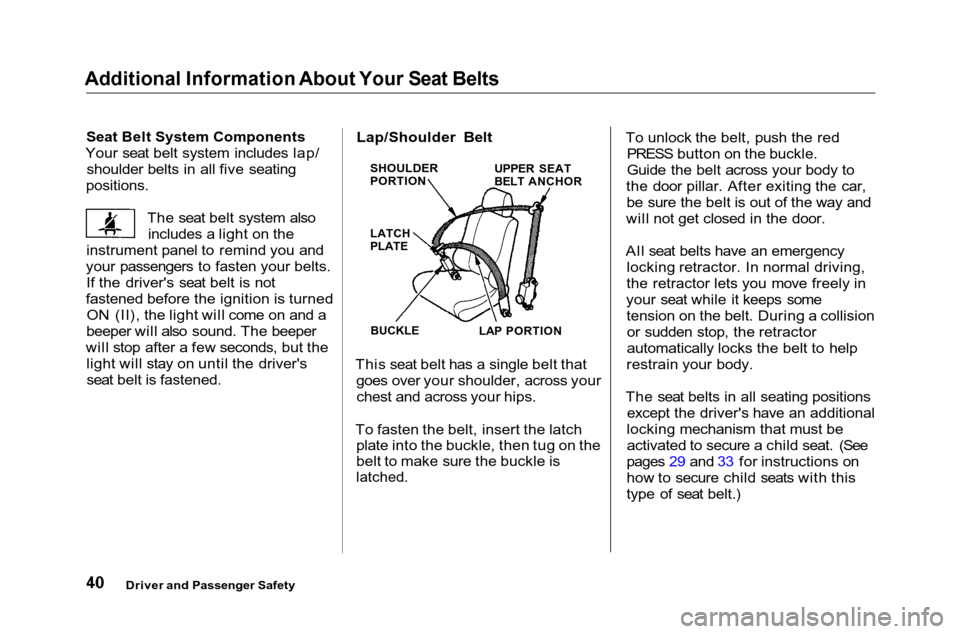
Additional Information About Your Seat Belts
Seat Belt System Components
Your seat belt system includes lap/ shoulder belts in all five seating
positions.
The seat belt system alsoincludes a light on the
instrument panel to remind you and
your passengers to fasten your belts. If the driver's seat belt is not
fastened before the ignition is turned ON (II), the light will come on and a
beeper will also sound. The beeper
will stop after a few seconds, but the light will stay on until the driver'sseat belt is fastened. Lap/Shoulder Belt
This seat belt has a single belt that goes over your shoulder, across yourchest and across your hips.
To fasten the belt, insert the latch plate into the buckle, then tug on the
belt to make sure the buckle is
latched.
To unlock the belt, push the red
PRESS button on the buckle.
Guide the belt across your body to
the door pillar. After exiting the car, be sure the belt is out of the way and
will not get closed in the door.
All seat belts have an emergency locking retractor. In normal driving,
the retractor lets you move freely in
your seat while it keeps some tension on the belt. During a collisionor sudden stop, the retractor
automatically locks the belt to help
restrain your body.
The seat belts in all seating positions except the driver's have an additional
locking mechanism that must be activated to secure a child seat. (See
pages 29 and 33 for instructions on
how to secure child seats with this
type of seat belt.)
Driver and Passenger Safety
SHOULDER
PORTION
UPPER SEAT
BELT ANCHOR
LATCH
PLATE
BUCKLE LAP PORTION
Page 54 of 372
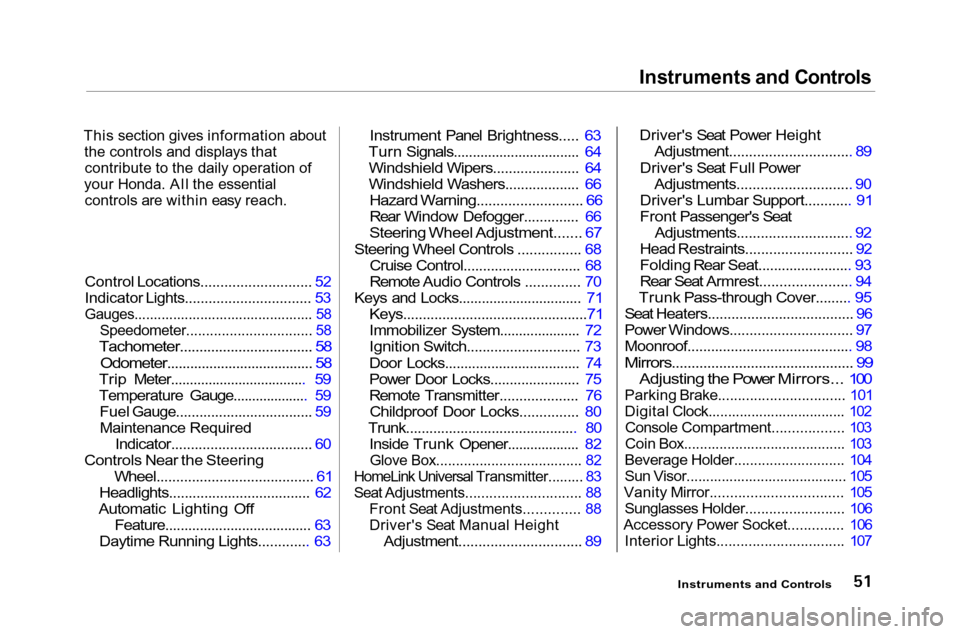
Instruments and Controls
This section gives information about
the controls and displays thatcontribute to the daily operation of
your Honda. All the essential
controls are within easy reach.
Control Locations............................ 52
Indicator Lights................................ 53
Gauges.............................................. 58
Speedometer................................ 58
Tachometer.................................. 58
Odometer...................................... 58
Trip Meter.................................... 59
Temperature Gauge.................... 59
Fuel Gauge................................... 59
Maintenance Required
Indicator.................................... 60
Controls Near the Steering Wheel........................................ 61
Headlights.................................... 62
Automatic Lighting Off Feature...................................... 63
Daytime Running Lights............. 63 Instrument Panel Brightness..... 63
Turn Signals................................. 64
Windshield Wipers...................... 64
Windshield Washers................... 66
Hazard Warning........................... 66
Rear Window Defogger.............. 66
Steering Wheel Adjustment....... 67
Steering Wheel Controls ................ 68 Cruise Control.............................. 68
Remote Audio Controls .............. 70
Keys and Locks................................ 71
Keys...............................................71
Immobilizer System..................... 72
Ignition Switch............................. 73
Door Locks................................... 74
Power Door Locks....................... 75
Remote Transmitter.................... 76Childproof Door Locks............... 80
Trunk............................................ 80 Inside Trunk Opener................... 82
Glove Box..................................... 82
HomeLink Universal Transmitter......... 83
Seat Adjustments............................. 88
Front Seat Adjustments.............. 88
Driver's Seat Manual Height
Adjustment............................... 89
Driver's Seat Power Height
Adjustment............................... 89
Driver's Seat Full Power
Adjustments............................. 90
Driver's Lumbar Support............ 91
Front Passenger's Seat
Adjustments............................. 92
Head Restraints........................... 92
Folding Rear Seat........................ 93
Rear Seat Armrest....................... 94
Trunk Pass-through Cover......... 95
Seat Heaters..................................... 96
Power Windows............................... 97
Moonroof.......................................... 98
Mirrors.............................................. 99
Adjusting the Power Mirrors... 100
Parking Brake................................ 101
Digital Clock................................... 102
Console Compartment.................. 103
Coin Box......................................... 103
Beverage Holder............................ 104
Sun Visor......................................... 105
Vanity Mirror................................. 105
Sunglasses Holder......................... 106
Accessory Power Socket.............. 106
Interior Lights................................ 107
Instruments and Controls